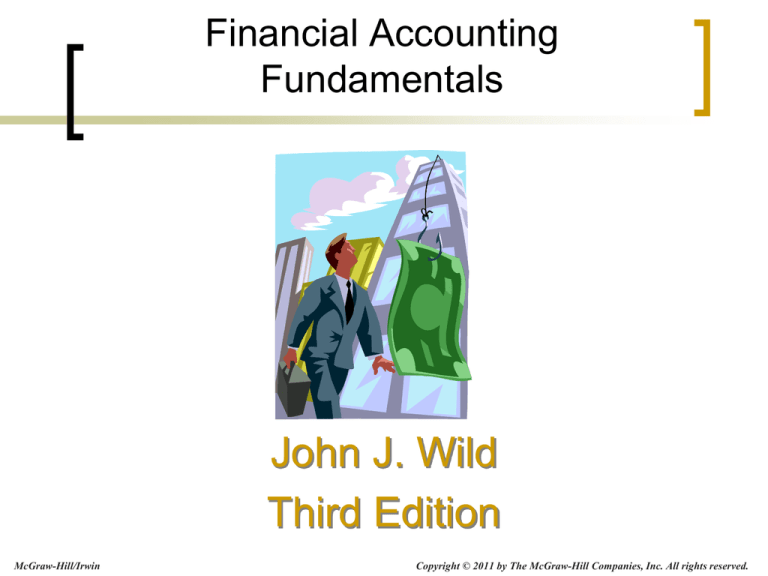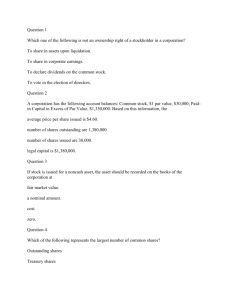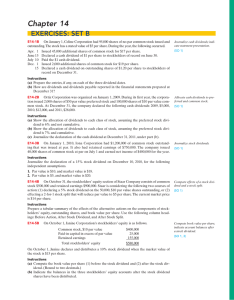
Financial Accounting
Fundamentals
John J. Wild
Third Edition
McGraw-Hill/Irwin
Copyright © 2011 by The McGraw-Hill Companies, Inc. All rights reserved.
Chapter 11
Accounting for Equity
Conceptual Learning Objectives
C1: Identify characteristics of
corporations and their organization.
C2: Explain characteristics of, and
distribute dividends between, common
and preferred stock.
C3: Explain the items reported in retained
earnings.
11-3
Analytical Learning Objectives
A1: Compute earnings per share and
describe its use.
A2: Compute price-earnings ratio and
describe its use in analysis.
A3: Compute dividend yield and explain
its use in analysis.
A4: Compute book value and explain its
use in analysis.
11-4
Procedural Learning Objectives
P1: Record the issuance of corporate stock.
P2: Record transactions involving cash
dividends, stock dividends, and stock splits.
P3: Record purchases and sales of treasury
stock and the retirement of stock.
11-5
C1
Characteristics of Corporations
Advantages
Separate legal entity
Limited liability of stockholders
Transferable ownership rights
Continuous life
Lack of mutual agency for stockholders
Ease of capital accumulation
Disadvantages
Governmental regulation
Corporate taxation
11-6
C2
Basics of Capital Stock
Total amount of stock that a
corporation’s charter authorizes it to sell.
Stockholders' Equity
Common Stock, par value $.01;
authorized 250,000,000 shares; issued
92,556,295 shares in 2011; 111,015,133
shares in 2010
2011
$925,563
2010
$1,110,151
Total amount of stock that has been issued or
sold to stockholders.
11-7
P1
Issuing Par Value Stock
Par Value Stock
On September 1, Matrix, Inc. issued 100,000
shares of $2 par value stock for $25 per share.
Let’s record this transaction.
Record:
1. The cash received.
2. The number of shares issued × the par value
per share in the Common Stock account.
3. The remainder is assigned to Paid-In Capital
in Excess of Par Value, Common Stock.
11-8
P2
Cash Dividends
Three important dates
Date of Declaration
Date of Record
Date of Payment
Record liability
for dividend.
No entry
required.
Record payment of
cash to stockholders.
11-9
P2
Stock Dividends
The corporation distributes additional shares
of its own stock to its stockholders without
receiving any payment in return.
Why a stock dividend?
100 shares
HotAir, Inc.
Common Stock
•Can be used to keep the market
price on the stock affordable.
$1 par
•Can provide evidence of
management’s confidence that
the company is doing well.
11-10
P2
Stock Splits
A distribution of additional shares of stock to
stockholders according to their percent
ownership.
$10 par value
Common Stock
Old
Shares
100 shares
$5 par value
New
Shares
Common Stock
200 shares
11-11
C2
Preferred Stock
A separate class of stock, typically having
priority over common shares in . . .
Dividend distributions
Distribution of assets in case of liquidation
Usually has a stated
dividend rate
Normally has no
voting rights
Corporations
with no
Preferred Stock
Corporations
with Preferred
Stock
73%
27%
11-12
P2
Cumulative or Noncumulative
Dividend
Cumulative
Dividends in arrears
must be paid before
dividends may be
paid on common
stock.
Vs.
Noncumulative
Undeclared dividends
from current and
prior years do not have
to be paid in future
years.
Most preferred stock
is cumulative.
11-13
C3
Statement of Retained Earnings
Total cumulative amount of reported net
income less any net losses and dividends
declared since the company started operating.
Reed, Inc.
Statement of Retained Earnings
For Year Ended December 31, 2011
Retained earnings, 1/1/11
$
875,000
Plus: net income
155,600
Less: dividends declared
Retained earnings, 12/31/11
(80,000)
950,600
$
11-14
C3
Statement of Stockholders’ Equity
Matrix, Inc.
Statement of Stockholders' Equity
For the Year Ended December 31, 2011
Common stock and
(In millions)
capital in excess of par
Shares
Amount
Balance at January 1, 2011
821
$
2,500
Stock sales
17
500
Stock repurchases and retirement
(17)
(260)
Cash dividends declared
Other, net
Net income
Balance at December 31, 2011
821
$
2,740
Retained
Earnings
$ 9,500
(925)
(150)
70
5,100
$ 13,595
Total
$ 12,000
500
(1,185)
(150)
70
5,100
$ 16,335
This is a more inclusive statement than the statement of
retained earnings.
11-15
End of Chapter 11
11-16








